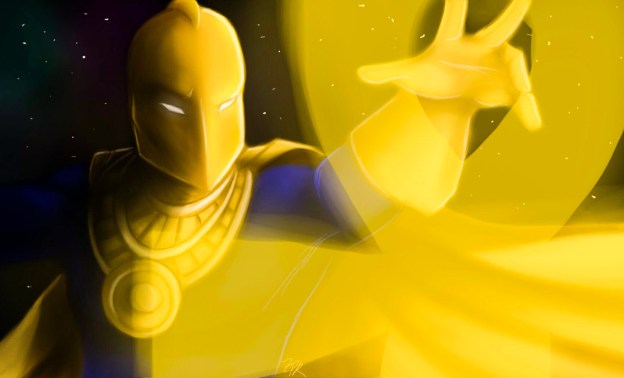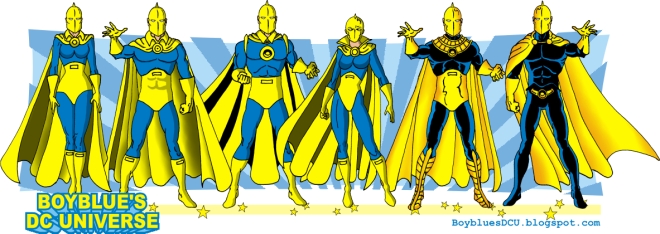In the 1940s comics that first featured Dr. Fate, his parents were a Swedish archaeologist and his spiritualist wife. In a larger, pop culture sense, however, he was the child of Helena Blavatsky and Howard Carter.
Like all the early heroes, he distilled elements that were floating around in the culture already. Both archaeology and spiritualism had their roots in the mid-1800s. Archaeology grew out of the attempt to trace the history of Biblical events, and to establish just how much of the actual narratives could be confirmed by outside evidence.
The Background, and Origin
In the wake of the post-Darwinian consensus that the world was much older than previously believed, the discoveries from Babylon and Assyria helped to fill in the blanks.
Spiritualism was popular as a rebellion against what people saw as the soulessness of the new, post-Darwinian cosmos. The high death tolls of World War I and the influenza epidemic that followed boosted its popularity. Spiritualists talked to the dead, and many found consolation in this. There were even spiritualist churches.
The followers of Blavatsky, on the other hand, saw talking to the dead as a waste of time – they were focused on what they saw as an “ancient mystery religion” handed down through the ages, which could give great power and wisdom to its adepts.
This religion was called Theosophy. Rather than seek to converse with the dead, Theosophists sought contact with “ascended masters” – adepts who passed on their wisdom from the afterlife. Kent Nelson, as we shall see, could be seen as an extremely successful Theosophist.
Ancient civilizations were thus given a new gloss. Far from being dead and gone, they held historical and mystical secrets that could be revealed to the seeker. (Failing wisdom, one could always hope for treasure.) Discoveries like Tutankhamun’s tomb and the excavations at Ur1 gave archaeology glamour in the public mind.

Promotional artwork for Countdown to Mystery #1 (Nov. 2007), featuring Kent V. Nelson as Doctor Fate. Cover art by Justiniano.
So Kent Nelson/Dr. Fate’s parents made perfect sense. They also adhered to the rule of superhero parents, and died while he was still young. Unusually, however, they died separately: his mother died soon after his birth, while his father died when he was twelve, from a version of the Mummy’s Curse.
Sven Nelson fell victim to a booby-trap set by the ancient Egyptians when he freed the sorcerer Nabu from his tomb. (Although Nabu is the name of a Sumero-Babylonian god, this Nabu is Egyptian.) His son, Kent Nelson, did not die, and Nabu then offered to teach Kent (then 12) his magical wisdom. The grieving boy refused.
Nabu then erased his memories of his father, and Kent Nelson’s magical tuition began. (Nabu might have been wise in magic, but he was not a nice man.)
When Kent had grown to manhood, Nabu also gave him magical objects: the helm of Thoth and amulet of Anubis. That Kent got his powers from a magician, rather than a god, is also a Theosophist touch.
For his first mission Nelson rescued Inza Cramer, who later settled down with him in his Tower of Fate (a sort of reverse Batcave) in Salem, Massachusetts.
As you can see, Fate’s origin is a combination of Shazam’s and Green Lantern’s: the orphan boy, the magical powers, the powerful object. Also, Nabu turned out to be not just a sorcerer, but one of the Lords of Order, who maintain the universe. (Like the Guardians of Oa in the Green Lantern comics.)
Magical Superheroes
Dr. Fate was one of the mystical superheroes: Shazam, The Spectre, Dr. Strange and many more. While many heroes either had no powers, or else had ones that could be explained in some pseudo-scientific way, these heroes simply bypassed all that and went straight for magic.
It makes sense that The Spectre, the living embodiment of God’s vengeance, often teamed up with Dr. Fate. They were two extremely powerful beings, even if they came from rather different mythos. The two were also founding members of the Justice Society, the first super-hero team. (The Justice Society was a 1940s group – the Justice League was the new, 1960s, version.)
There he would meet another character influenced by the interest in all things Egyptian: Hawkman. (Since Carter Hall was an archaeologist himself, they must have had some interesting discussions.)
Inza Cramer/Nelson
Kent Nelson, as I mentioned above, rescued a woman named Inza Cramer early in his career as Dr. Fate. She moved into the Tower of Fate with him, and his magic kept both of them young. She came to resent what she saw as imprisonment in the Tower, and the way the helmet possessed her husband.
Later, in the 1990s comics, Inza actually became Dr. Fate, in a major plot twist. At first she became Dr. Fate all by herself, but eventually she learned that she and Kent Nelson were supposed to merge to become the super-hero, and that the Lords of Order had always meant Dr. Fate to be a man and a woman. This gave an interesting gender twist to an old comic character.
New 52 and Khalid Nassour
In June 2015 DC relaunched Dr. Fate as part of its new, rebooted, universe, this time as a medical student named Khalid Nassour, whose father immigrated to the US from Egypt.
The story is that the ancient Egyptian gods Anubis and Bastet are at war over the fate of the Earth, with Anubis wanting to flood it and start over, while Bastet wants to save humanity, recruiting Khalid to help her.
This can seem a bit weird in the comic, since it looks like a magical fight between a cat and a dog. However, Anubis was a god of the afterworld, guiding and judging souls, while Bastet was a protective goddess with a joyful approach to life, so their conflict makes some kind of sense. (They had a very different relationship in Egyptian myth.)
This should become more significant in future issues, as Khalid “dies” and he and Anubis journey through the Egyptian afterworld. Up until now the story has been about Khalid trying to come to terms with the powers given him by the helm of Nabu, and how it has changed his life. This should take him into the cosmic, magical realms that are Dr. Fate’s home turf.
While Hawkman is going to be part of the new DC universe on TV, no mention has been made of Dr. Fate. He did have a small part in the Smallville show back in the 90s, so perhaps as time goes on…
1. One of the archaeologists accompanying Leonard Woolley at Ur was Max Mallowan, the second husband of Agatha Christie. Her travels in the Middle East inspired several of her detective novels, including Death on the Nile and Murder in Mesopotamia. (They actually met at the Ur site.)↩
Links:
DC Wiki entry on Dr. Fate
Comic Vine bio of Kent Nelson
Tower of Fate, a fanblog (Now gone, alas, although you can find it on the Wayback Machine.)
A list of essential Dr. Fate comics
A video version of his origin
Featured image by ZombiePunkRat at deviant.art (link broken)



Nice post – I haven’t seen heroes like Dr. Fate put in the context of historical mysticism this way before, but it makes a lot of sense.
LikeLike
Thanks – it’s hard to find something new to say about heroes, but I was intrigued by Fates’s backstory.
LikeLike
Historical mysticism is a new concept for me. I find the image intriguing. My own reality of God the Holy Spirit as Divine from beginning to end ie (no matter how old the earth actually is) somehow anchors me so mysticism from ages past is ‘extra’ fascinating. Heroes always inspire thoughts. Thank you.
LikeLiked by 1 person